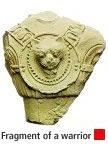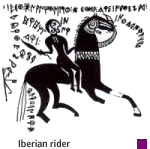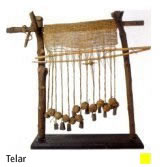
The socio-political organization of the Iberian civilization
 Some tribes inlands like the ilergetes or the ausetans (Osona) were
governed by kings. It seems that in the case of the first ones it
happened by two kings sharing the power at the same time (diarquia).
Some tribes inlands like the ilergetes or the ausetans (Osona) were
governed by kings. It seems that in the case of the first ones it
happened by two kings sharing the power at the same time (diarquia).
This form of government was established in the lower Iberian epoch, still in roman period and was hereditary.
The tribes of the coast contrariwise and permanently in contact with the Greek and other foreign nations were motivated by economic interests and created socio-political more equalitarian structures.
These populations treating directly with the Greeks did not develop a political elite, sharing benefits on an equalitarian way.
The political aristocratic forms, belated, of the tribes inlands are consequence of their contact with the Carthaginians and later the Romans, people with a social and political structure totally different to the Greeks.
Probably this late genesis of strong political structures between the Catalan Ibers explains that capitalities did not appear until the arrival of Romans in the year 218 a.n.e. and was surely fomented by those.
 Up to that time the only system of political social organisation
existing was the tribal with a regional distribution and an economic centre channelling the foreign trade.
Up to that time the only system of political social organisation
existing was the tribal with a regional distribution and an economic centre channelling the foreign trade.
When the consul Cató pacified the tribes in the North of the Ebro on 195 a.n.e., their representatives were not others as family heads of the respective villages. In the North of the Ebro it seems that there was no social stratification, more an *equalitarian society* and, as said, the formation of a royalty succeed much more later and propitiated by theroman conquest.
 The family heads, as they had a patriarchal society, should designate
the different works to the members of the community. It seems that the catalan coast had a much more higher density of
villages as the inner regions.
The family heads, as they had a patriarchal society, should designate
the different works to the members of the community. It seems that the catalan coast had a much more higher density of
villages as the inner regions.
Between these tribes of the catalan territory there were cultural differences, many times revealed in written documents.
So the historian, Titus Livi, tells that the lacetans often attacked their neighbours, the ausetans, and some written plumbs with curses of the olossitanians (Ibers of the Garrotxa) against their neighbours, the indigetes give proof of their more open character, habituated to contact foreigners and generally more civilized of the tribes of the coast regarding to those poorer and indomitable tribes in the mountains.
The only tribe who managed to get an alliance with others to fight against the Romans, like that one of the ausetans, were the ilergets.
 Each tribe had an own battle cry and their banners. The family, even having a patriarchal character seems to have the woman
as protagonist of religious ceremonies like a priestess.
Each tribe had an own battle cry and their banners. The family, even having a patriarchal character seems to have the woman
as protagonist of religious ceremonies like a priestess.
Families were monogamous and the ties between them very strong. The strong winkles of relatives between them due to a patrilineal line constituting the clan, anyhow it can not be excluded a transmission of heritages on matrilineal way.
Definitely the woman had a very important role in the economic system as she had further from agricultural and domestic work also the pottery room and the clothes. Those elements were very important and indispensable for life in the village.